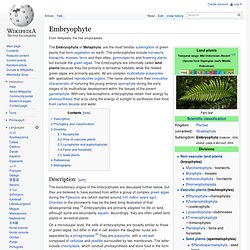

Marchantiophyta (Liverworts) Embryophyta. Plant. Green plants obtain most of their energy from sunlight via photosynthesis by primary chloroplasts that are derived from endosymbiosis with cyanobacteria.

Their chloroplasts contain chlorophylls a and b, which gives them their green color. Some plants are parasitic or mycotrophic and have lost the ability to produce normal amounts of chlorophyll or to photosynthesize. Plants are characterized by sexual reproduction and alternation of generations, although asexual reproduction is also common. There are about 320 thousand species of plants, of which the great majority, some 260–290 thousand, are seed plants (see the table below).[5] Green plants provide a substantial proportion of the world's molecular oxygen[6] and are the basis of most of Earth's ecosystems, especially on land. Plants that produce grain, fruit and vegetables form humankind's basic foods, and have been domesticated for millennia. Embryophyte. The Embryophyta or Metaphyta, are the most familiar subkingdom of green plants that form vegetation on earth.

The embryophytes include hornworts, liverworts, mosses, ferns and their allies, gymnosperms and flowering plants, but exclude the green algae. The Embryophyta are informally called land plants because they live primarily in terrestrial habitats, while the related green algae are primarily aquatic. All are complex multicellular eukaryotes with specialized reproductive organs. The name derives from their innovative characteristic of nurturing the young embryo sporophyte during the early stages of its multicellular development within the tissues of the parent gametophyte. With very few exceptions, embryophytes obtain their energy by photosynthesis, that is by using the energy of sunlight to synthesize their food from carbon dioxide and water.